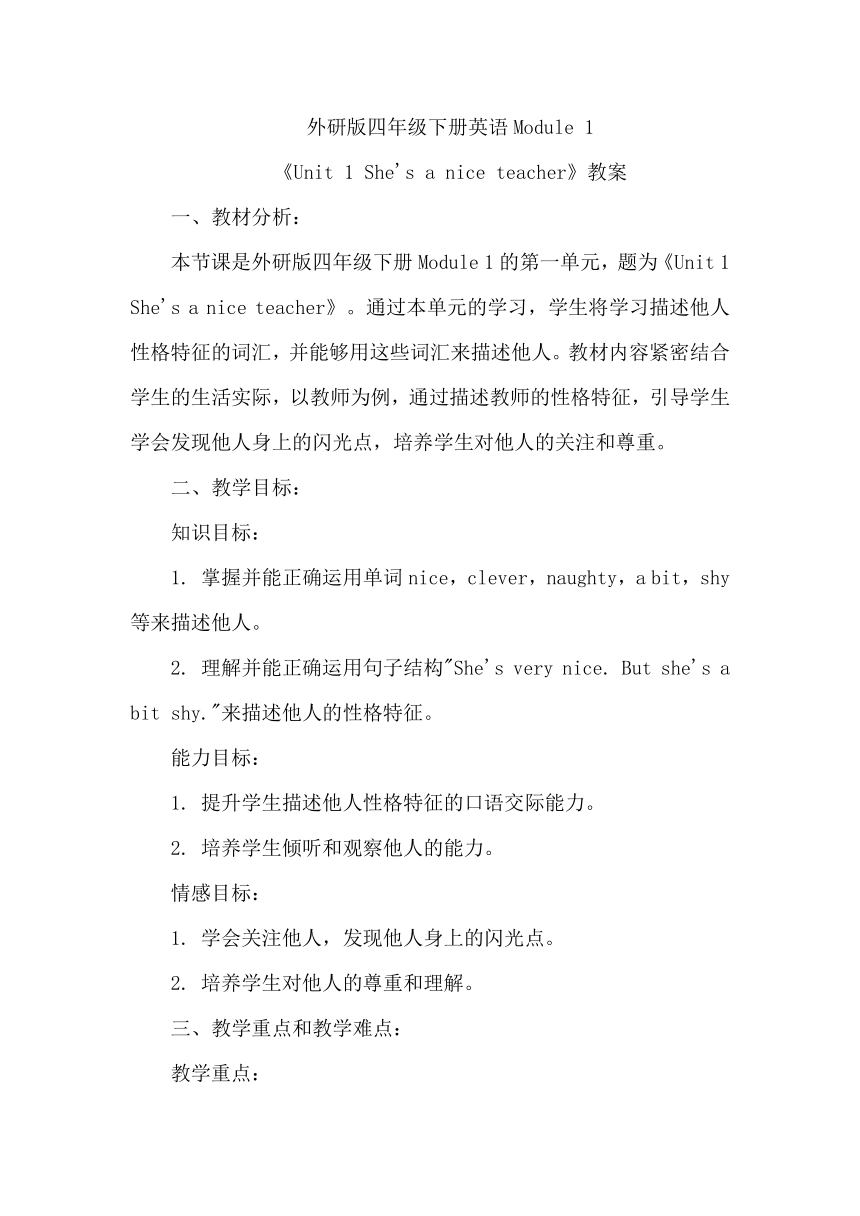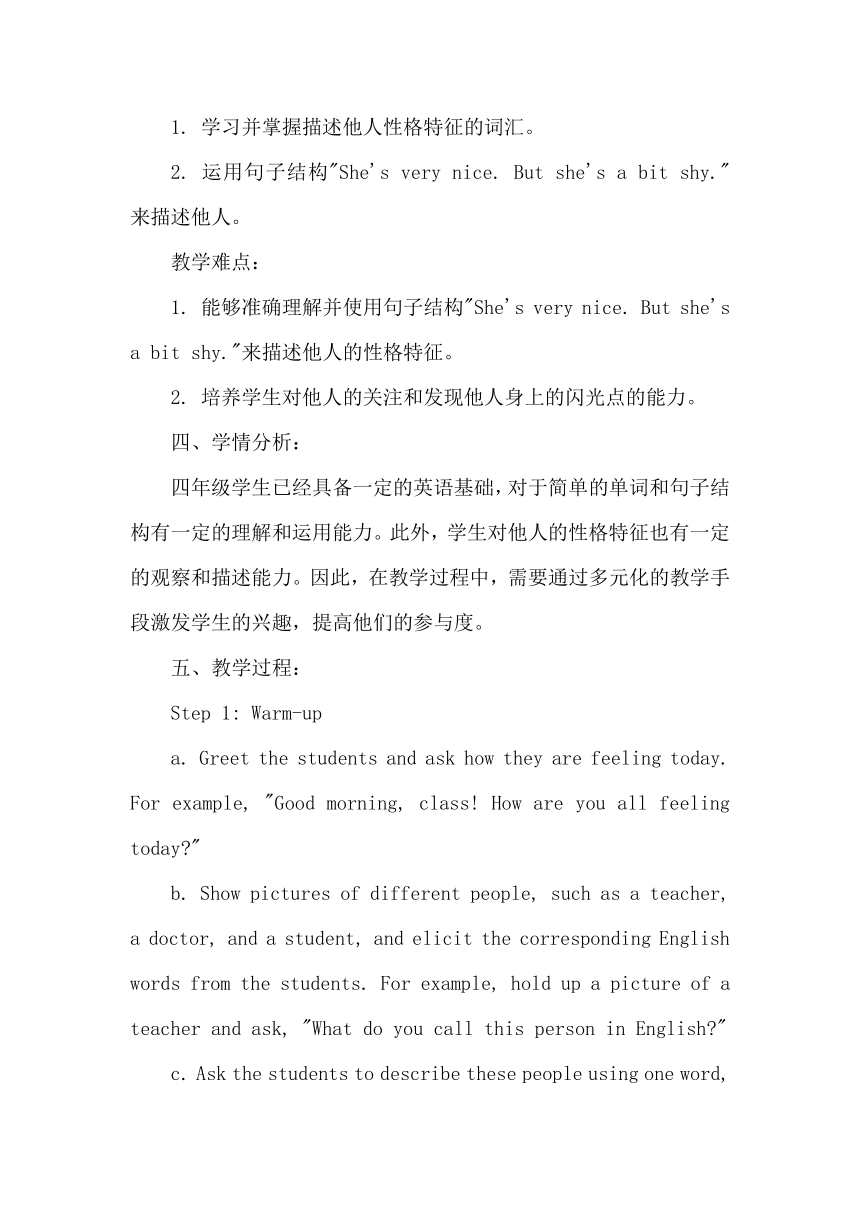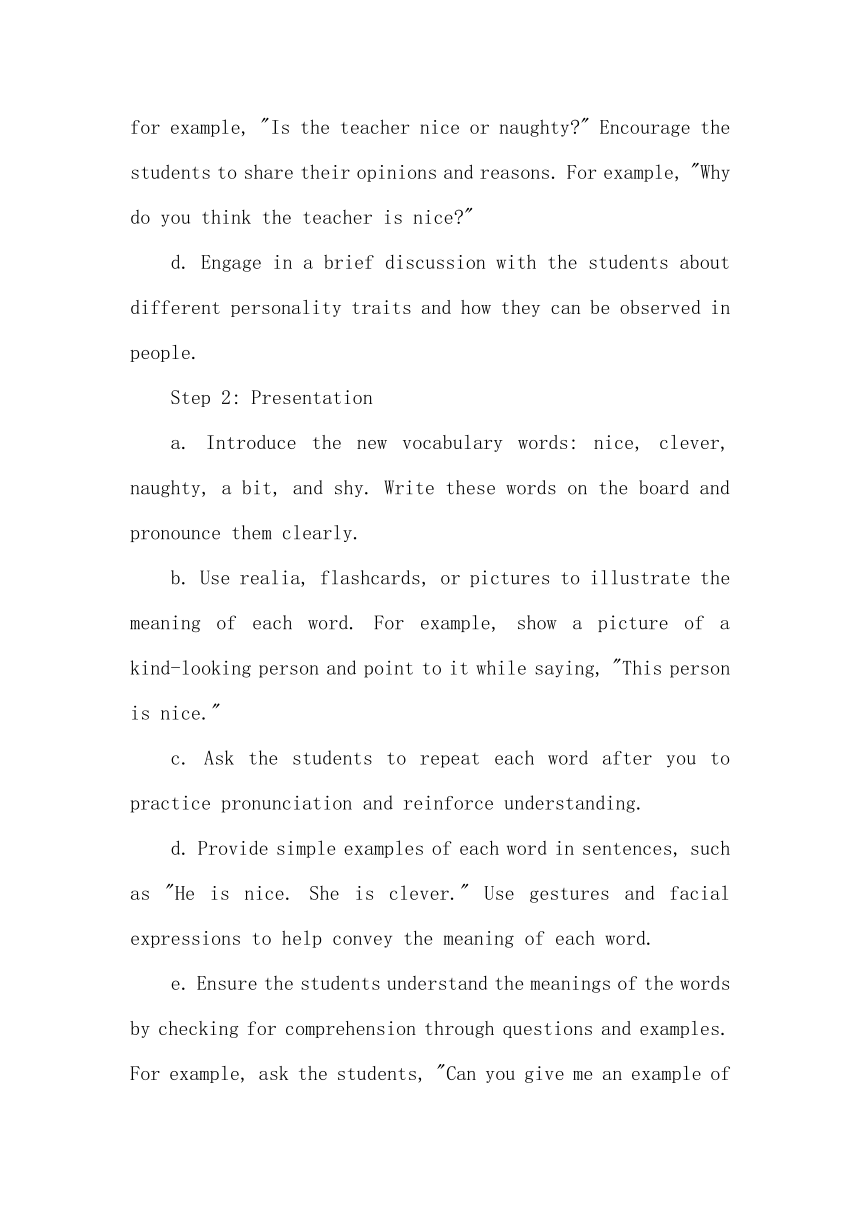Module 1 Unit 1 She's a nice teacher 教案(含反思)
文档属性
| 名称 | Module 1 Unit 1 She's a nice teacher 教案(含反思) |  | |
| 格式 | docx | ||
| 文件大小 | 14.1KB | ||
| 资源类型 | 教案 | ||
| 版本资源 | 外研版(三年级起点) | ||
| 科目 | 英语 | ||
| 更新时间 | 2024-02-17 10:13:48 | ||
图片预览



文档简介
外研版四年级下册英语Module 1
《Unit 1 She's a nice teacher》教案
一、教材分析:
本节课是外研版四年级下册Module 1的第一单元,题为《Unit 1 She's a nice teacher》。通过本单元的学习,学生将学习描述他人性格特征的词汇,并能够用这些词汇来描述他人。教材内容紧密结合学生的生活实际,以教师为例,通过描述教师的性格特征,引导学生学会发现他人身上的闪光点,培养学生对他人的关注和尊重。
二、教学目标:
知识目标:
1. 掌握并能正确运用单词nice,clever,naughty,a bit,shy等来描述他人。
2. 理解并能正确运用句子结构"She's very nice. But she's a bit shy."来描述他人的性格特征。
能力目标:
1. 提升学生描述他人性格特征的口语交际能力。
2. 培养学生倾听和观察他人的能力。
情感目标:
1. 学会关注他人,发现他人身上的闪光点。
2. 培养学生对他人的尊重和理解。
三、教学重点和教学难点:
教学重点:
1. 学习并掌握描述他人性格特征的词汇。
2. 运用句子结构"She's very nice. But she's a bit shy."来描述他人。
教学难点:
1. 能够准确理解并使用句子结构"She's very nice. But she's a bit shy."来描述他人的性格特征。
2. 培养学生对他人的关注和发现他人身上的闪光点的能力。
四、学情分析:
四年级学生已经具备一定的英语基础,对于简单的单词和句子结构有一定的理解和运用能力。此外,学生对他人的性格特征也有一定的观察和描述能力。因此,在教学过程中,需要通过多元化的教学手段激发学生的兴趣,提高他们的参与度。
五、教学过程:
Step 1: Warm-up
a. Greet the students and ask how they are feeling today. For example, "Good morning, class! How are you all feeling today "
b. Show pictures of different people, such as a teacher, a doctor, and a student, and elicit the corresponding English words from the students. For example, hold up a picture of a teacher and ask, "What do you call this person in English "
c. Ask the students to describe these people using one word, for example, "Is the teacher nice or naughty " Encourage the students to share their opinions and reasons. For example, "Why do you think the teacher is nice "
d. Engage in a brief discussion with the students about different personality traits and how they can be observed in people.
Step 2: Presentation
a. Introduce the new vocabulary words: nice, clever, naughty, a bit, and shy. Write these words on the board and pronounce them clearly.
b. Use realia, flashcards, or pictures to illustrate the meaning of each word. For example, show a picture of a kind-looking person and point to it while saying, "This person is nice."
c. Ask the students to repeat each word after you to practice pronunciation and reinforce understanding.
d. Provide simple examples of each word in sentences, such as "He is nice. She is clever." Use gestures and facial expressions to help convey the meaning of each word.
e. Ensure the students understand the meanings of the words by checking for comprehension through questions and examples. For example, ask the students, "Can you give me an example of someone who is clever "
Step 3: Practice
a. Divide the class into pairs or small groups.
b. Distribute worksheets with pictures of different people and a blank space next to each picture.
c. Instruct the students to work together to choose one word from the vocabulary list to describe each person in the picture. They should write the word in the blank space. Encourage them to discuss their choices and provide reasons for their descriptions.
d. Monitor the students' progress and provide assistance as needed. Circulate around the classroom, listening to their conversations and offering guidance.
e. After completing the task, ask some pairs or groups to share their descriptions with the whole class. Encourage other students to listen and provide feedback or alternative descriptions.
Step 4: Listening and Speaking
a. Play an audio recording or read aloud a short dialogue describing a teacher's personality, using the target vocabulary words. For example, "The teacher is very nice and helpful, but sometimes she can be a bit shy."
b. Ask the students to listen carefully and identify the words they hear. You can pause after each sentence to allow them time to process the information.
c. Play the recording or read the dialogue again, pausing after each sentence to check the students' understanding. Ask questions like "Is the teacher nice or naughty " or "What does 'a bit shy' mean "
d. Discuss the dialogue as a class, encouraging students to share their thoughts and opinions. Engage in a conversation about different personality traits and how they can be observed in teachers and other people.
e. Model the sentence structure "She's very nice. But she's a bit shy." and ask the students to practice saying it aloud. Provide additional examples using different vocabulary words, such as "He's very clever. But he's a bit naughty."
Step 5: Role Play
a. Divide the class into pairs or small groups.
b. Provide each group with a role-play scenario, for example, a student describing their teacher to a friend. You can give them prompts like "Your friend is new to the school, and you want to tell them about your teacher."
c. Encourage the students to use the vocabulary words and the sentence structure from the previous activities to create their own dialogues. They should take turns playing the role of the student and the friend.
d. Allow time for the groups to practice their role-plays. Circulate around the classroom, providing guidance and support as needed.
e. Invite some groups to perform their role-plays in front of the class. After each performance, encourage the other students to provide feedback and suggestions for improvement.
Step 6: Wrap-up
a. Summarize the key vocabulary words and sentence structure learned in this lesson. Write them on the board and ask the students to repeat them together.
b. Give a few examples of sentences using the target vocabulary words and sentence structure. For example, "She's very nice. But she's a bit shy. He's very clever. But he can be a bit naughty sometimes."
c. Encourage the students to continue observing and describing people's personalities in their daily lives. Remind them to use the vocabulary and sentence structure they have learned to express their observations.
六、板书设计:
Nice Clever Naughty
A bit Shy
She's very nice. But she's a bit shy.
七、教学反思:
本节课通过引入新的词汇和句子结构,培养了学生描述他人性格特征的能力。学生通过多种形式的练习,如个人描述、对话和角色扮演,巩固了所学内容,并在实际情境中运用。通过观察和描述他人,学生也培养了对他人的关注和尊重。在今后的教学中,可以进一步引导学生运用所学的词汇和句子结构来描述不同的人物,拓展他们的口语表达能力。
《Unit 1 She's a nice teacher》教案
一、教材分析:
本节课是外研版四年级下册Module 1的第一单元,题为《Unit 1 She's a nice teacher》。通过本单元的学习,学生将学习描述他人性格特征的词汇,并能够用这些词汇来描述他人。教材内容紧密结合学生的生活实际,以教师为例,通过描述教师的性格特征,引导学生学会发现他人身上的闪光点,培养学生对他人的关注和尊重。
二、教学目标:
知识目标:
1. 掌握并能正确运用单词nice,clever,naughty,a bit,shy等来描述他人。
2. 理解并能正确运用句子结构"She's very nice. But she's a bit shy."来描述他人的性格特征。
能力目标:
1. 提升学生描述他人性格特征的口语交际能力。
2. 培养学生倾听和观察他人的能力。
情感目标:
1. 学会关注他人,发现他人身上的闪光点。
2. 培养学生对他人的尊重和理解。
三、教学重点和教学难点:
教学重点:
1. 学习并掌握描述他人性格特征的词汇。
2. 运用句子结构"She's very nice. But she's a bit shy."来描述他人。
教学难点:
1. 能够准确理解并使用句子结构"She's very nice. But she's a bit shy."来描述他人的性格特征。
2. 培养学生对他人的关注和发现他人身上的闪光点的能力。
四、学情分析:
四年级学生已经具备一定的英语基础,对于简单的单词和句子结构有一定的理解和运用能力。此外,学生对他人的性格特征也有一定的观察和描述能力。因此,在教学过程中,需要通过多元化的教学手段激发学生的兴趣,提高他们的参与度。
五、教学过程:
Step 1: Warm-up
a. Greet the students and ask how they are feeling today. For example, "Good morning, class! How are you all feeling today "
b. Show pictures of different people, such as a teacher, a doctor, and a student, and elicit the corresponding English words from the students. For example, hold up a picture of a teacher and ask, "What do you call this person in English "
c. Ask the students to describe these people using one word, for example, "Is the teacher nice or naughty " Encourage the students to share their opinions and reasons. For example, "Why do you think the teacher is nice "
d. Engage in a brief discussion with the students about different personality traits and how they can be observed in people.
Step 2: Presentation
a. Introduce the new vocabulary words: nice, clever, naughty, a bit, and shy. Write these words on the board and pronounce them clearly.
b. Use realia, flashcards, or pictures to illustrate the meaning of each word. For example, show a picture of a kind-looking person and point to it while saying, "This person is nice."
c. Ask the students to repeat each word after you to practice pronunciation and reinforce understanding.
d. Provide simple examples of each word in sentences, such as "He is nice. She is clever." Use gestures and facial expressions to help convey the meaning of each word.
e. Ensure the students understand the meanings of the words by checking for comprehension through questions and examples. For example, ask the students, "Can you give me an example of someone who is clever "
Step 3: Practice
a. Divide the class into pairs or small groups.
b. Distribute worksheets with pictures of different people and a blank space next to each picture.
c. Instruct the students to work together to choose one word from the vocabulary list to describe each person in the picture. They should write the word in the blank space. Encourage them to discuss their choices and provide reasons for their descriptions.
d. Monitor the students' progress and provide assistance as needed. Circulate around the classroom, listening to their conversations and offering guidance.
e. After completing the task, ask some pairs or groups to share their descriptions with the whole class. Encourage other students to listen and provide feedback or alternative descriptions.
Step 4: Listening and Speaking
a. Play an audio recording or read aloud a short dialogue describing a teacher's personality, using the target vocabulary words. For example, "The teacher is very nice and helpful, but sometimes she can be a bit shy."
b. Ask the students to listen carefully and identify the words they hear. You can pause after each sentence to allow them time to process the information.
c. Play the recording or read the dialogue again, pausing after each sentence to check the students' understanding. Ask questions like "Is the teacher nice or naughty " or "What does 'a bit shy' mean "
d. Discuss the dialogue as a class, encouraging students to share their thoughts and opinions. Engage in a conversation about different personality traits and how they can be observed in teachers and other people.
e. Model the sentence structure "She's very nice. But she's a bit shy." and ask the students to practice saying it aloud. Provide additional examples using different vocabulary words, such as "He's very clever. But he's a bit naughty."
Step 5: Role Play
a. Divide the class into pairs or small groups.
b. Provide each group with a role-play scenario, for example, a student describing their teacher to a friend. You can give them prompts like "Your friend is new to the school, and you want to tell them about your teacher."
c. Encourage the students to use the vocabulary words and the sentence structure from the previous activities to create their own dialogues. They should take turns playing the role of the student and the friend.
d. Allow time for the groups to practice their role-plays. Circulate around the classroom, providing guidance and support as needed.
e. Invite some groups to perform their role-plays in front of the class. After each performance, encourage the other students to provide feedback and suggestions for improvement.
Step 6: Wrap-up
a. Summarize the key vocabulary words and sentence structure learned in this lesson. Write them on the board and ask the students to repeat them together.
b. Give a few examples of sentences using the target vocabulary words and sentence structure. For example, "She's very nice. But she's a bit shy. He's very clever. But he can be a bit naughty sometimes."
c. Encourage the students to continue observing and describing people's personalities in their daily lives. Remind them to use the vocabulary and sentence structure they have learned to express their observations.
六、板书设计:
Nice Clever Naughty
A bit Shy
She's very nice. But she's a bit shy.
七、教学反思:
本节课通过引入新的词汇和句子结构,培养了学生描述他人性格特征的能力。学生通过多种形式的练习,如个人描述、对话和角色扮演,巩固了所学内容,并在实际情境中运用。通过观察和描述他人,学生也培养了对他人的关注和尊重。在今后的教学中,可以进一步引导学生运用所学的词汇和句子结构来描述不同的人物,拓展他们的口语表达能力。
同课章节目录
- Module 1
- Unit 1 She's a nice teache
- Unit 2 He's cool.
- Module 2
- Unit 1 London is a big city.
- Unit 2 It's very old.
- Module 3
- Unit 1 Robots will do everything.
- Unit 2 On Monday I'll go swimming.
- Module 4
- Unit 1 Will you take your kite?
- Unit 2 Will it be hot in Haikou?
- Module 5
- Unit 1 I was two then.
- Unit 2 They were young.
- Module 6
- Unit 1 Were you at home yesterday?
- Unit 2 Was it a big city then ?
- Module 7
- Unit 1 I helped Mum.
- Unit 2 Grandma cooked fish.
- Module 8
- Unit 1 They sang beautifully.
- Unit 2 I took some pictures.
- Module 9
- Unit 1 Did he live in New York ?
- Unit 2 Did you have a nice holiday?
- Review Module
- Unit 1
- Unit 2
- Module 10
- Unit 1 Did you fall off your bike?
- Unit 2 Sam had lots of chocolate.
